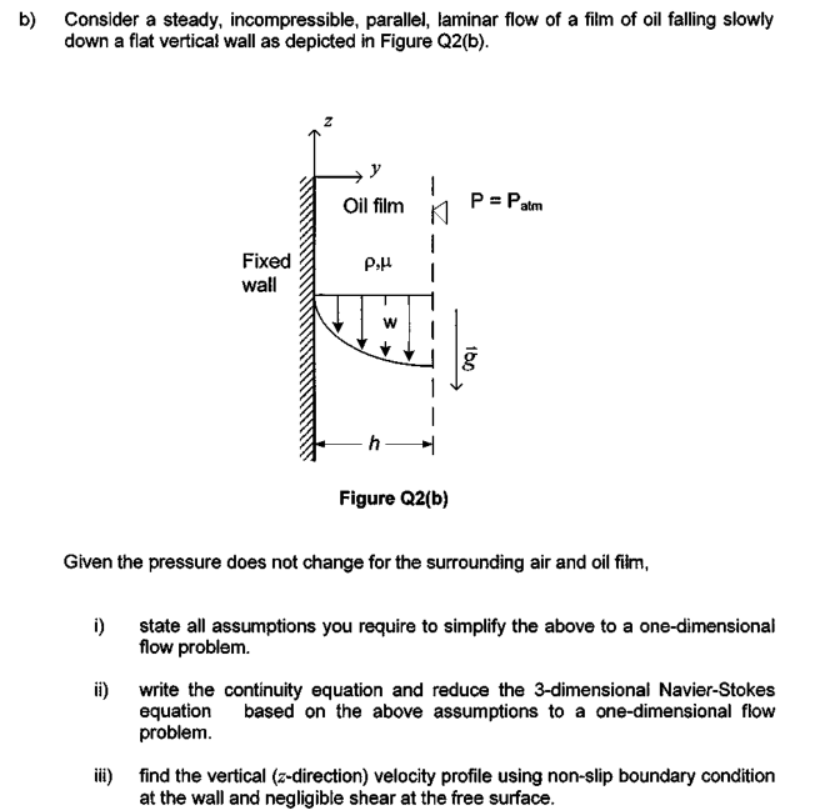b) Consider a steady, incompressible, parallel, laminar flow of a film of oil falling slowly down a flat vertical wall as depicted in Figure Q2(b). Oil film P = Patm Fixed wall h- Figure Q2(b) Given the pressure does not change for the surrounding air and oil film, i) state all assumptions you require to simplify the above to a one-dimensional flow problem. i) write the continuity equation and reduce the 3-dimensional Navier-Stokes equation problem. based on the above assumptions to a one-dimensional flow ili) find the vertical (z-direction) velocity profile using non-slip boundary condition at the wall and negligible shear at the free surface. 160
b) Consider a steady, incompressible, parallel, laminar flow of a film of oil falling slowly down a flat vertical wall as depicted in Figure Q2(b). Oil film P = Patm Fixed wall h- Figure Q2(b) Given the pressure does not change for the surrounding air and oil film, i) state all assumptions you require to simplify the above to a one-dimensional flow problem. i) write the continuity equation and reduce the 3-dimensional Navier-Stokes equation problem. based on the above assumptions to a one-dimensional flow ili) find the vertical (z-direction) velocity profile using non-slip boundary condition at the wall and negligible shear at the free surface. 160
Elements Of Electromagnetics
7th Edition
ISBN:9780190698614
Author:Sadiku, Matthew N. O.
Publisher:Sadiku, Matthew N. O.
ChapterMA: Math Assessment
Section: Chapter Questions
Problem 1.1MA
Related questions
Question

Transcribed Image Text:b)
Consider a steady, incompressible, parallel, laminar flow of a film of oil falling slowly
down a flat vertical wall as depicted in Figure Q2(b).
Oil film
P= Patm
Fixed
wall
Figure Q2(b)
Given the pressure does not change for the surrounding air and oil film,
i)
state all assumptions you require to simplify the above to a one-dimensional
flow problem.
ii)
write the continuity equation and reduce the 3-dimensional Navier-Stokes
equation
problem.
based on the above assumptions to a one-dimensional flow
ii)
find the vertical (z-direction) velocity profile using non-slip boundary condition
at the wall and negligible shear at the free surface.
160
Expert Solution
This question has been solved!
Explore an expertly crafted, step-by-step solution for a thorough understanding of key concepts.
This is a popular solution!
Trending now
This is a popular solution!
Step by step
Solved in 2 steps

Knowledge Booster
Learn more about
Need a deep-dive on the concept behind this application? Look no further. Learn more about this topic, mechanical-engineering and related others by exploring similar questions and additional content below.Recommended textbooks for you

Elements Of Electromagnetics
Mechanical Engineering
ISBN:
9780190698614
Author:
Sadiku, Matthew N. O.
Publisher:
Oxford University Press

Mechanics of Materials (10th Edition)
Mechanical Engineering
ISBN:
9780134319650
Author:
Russell C. Hibbeler
Publisher:
PEARSON

Thermodynamics: An Engineering Approach
Mechanical Engineering
ISBN:
9781259822674
Author:
Yunus A. Cengel Dr., Michael A. Boles
Publisher:
McGraw-Hill Education

Elements Of Electromagnetics
Mechanical Engineering
ISBN:
9780190698614
Author:
Sadiku, Matthew N. O.
Publisher:
Oxford University Press

Mechanics of Materials (10th Edition)
Mechanical Engineering
ISBN:
9780134319650
Author:
Russell C. Hibbeler
Publisher:
PEARSON

Thermodynamics: An Engineering Approach
Mechanical Engineering
ISBN:
9781259822674
Author:
Yunus A. Cengel Dr., Michael A. Boles
Publisher:
McGraw-Hill Education

Control Systems Engineering
Mechanical Engineering
ISBN:
9781118170519
Author:
Norman S. Nise
Publisher:
WILEY

Mechanics of Materials (MindTap Course List)
Mechanical Engineering
ISBN:
9781337093347
Author:
Barry J. Goodno, James M. Gere
Publisher:
Cengage Learning

Engineering Mechanics: Statics
Mechanical Engineering
ISBN:
9781118807330
Author:
James L. Meriam, L. G. Kraige, J. N. Bolton
Publisher:
WILEY